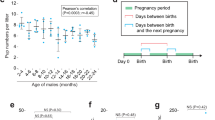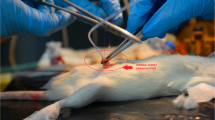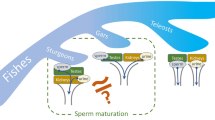Abstract
THE maturation of spermatozoa during passage through the mammalian epididymis, involves changes in motility, metabolism, morphology, biochemical properties and the development of the ability to fertilise ova1. This maturation process, and the maintenance of fertilising ability, is dependent on androgen2. When testosterone levels are lowered by castration or hypophysectomy, sperm from the cauda epididymis have immature acrosomes (guinea pig)3 and lowered fertilising ability (rat)4. These effects are prevented by testosterone treatment. Since reduction of testosterone levels enhances the rate of epididymal sperm transport4,5, the incomplete maturation could result from spermatozoa spending insufficient time in critical regions of the epididymis, as well as from a decreased ability of the epididymis to promote sperm maturation. We demonstrate here that oestrogen and testosterone affect one aspect of sperm maturation in mice by altering the rate of epididymal sperm transport, and also affect fertility.
This is a preview of subscription content, access via your institution
Access options
Subscribe to this journal
Receive 51 print issues and online access
$199.00 per year
only $3.90 per issue
Buy this article
- Purchase on Springer Link
- Instant access to full article PDF
Prices may be subject to local taxes which are calculated during checkout
Similar content being viewed by others
References
Bedford, J. M., in Handbook of Physiology, 5 (edit. by Greep, R. O., and Astwood, E.B.), 303–317 (American Physiology Society, Washington DC, 1975).
Orgebin-Crist, M. C., Danzo, B. J., and Davies, J., in Handbook of Physiology, 5 (edit. by Greep, R. O., and Astwood, E. B.) 319–338 (American Physiology Society, Washington DC, 1975).
Blaquier, J. A., Cameo, M. S., and Burgos, M. H., Endocrinology, 90, 839–842 (1972).
Dyson, A. L. M. B., and Orgebin-Crist, M. C., Endocrinology, 93, 391–402 (1973).
Das, R. P., Roy, S., and Bandopadhyaya, G. P., Contraception, 8, 471–484 (1973).
Meistrich, M. L., Rejd, B. O., and Barcellona, W. J., Expl Cell Res. (in the press).
Shimkin, M. B., Smith, S. J., Shimkin, P. M., and Andervont, H. B., J. natn., Cancer Inst., 28, 1219–1231 (1962).
Orgebin-Crist, M. C., J. Reprod. Fert., 15, 15–25 (1968).
Calvin, H. I., and Bedford, J. M., J. Reprod. Fert. Suppl., 13, 65–75 (1971).
Risley, R. L., in Mechanisms Concerned with Conception (edit. by Hartman, C. G.) 73–133 (MacMillan, New York, 1963).
Orgebin-Crist, M. C., and Davies, J., Cell Tissue Res., 148, 183–201 (1974).
Chowdhury, M., Tcholakian, R., and Steinberger, E., J. Endocr., 60, 375–376 (1974).
Huseby, R. A., Dominguez, O. V., and Samuels, L. T., Rec. prog. Horm. Res., 17, 1–51 (1961).
Lubicz-Nawrocki, C. M., J. Endocr., 61, 133–138 (1974).
Rennie, P., and Bruchovsky, N., J. biol. Chem., 248, 3288–3297 (1973).
van Beurden-Lamers, W. M. O., Brinkmann, S. E., Mulder, E., and van der Molen, H. J., Biochem., J., 140, 495–502 (1974).
Author information
Authors and Affiliations
Rights and permissions
About this article
Cite this article
MEISTRICH, M., HUGHES, T. & BRUCE, W. Alteration of epididymal sperm transport and maturation in mice by oestrogen and testosterone. Nature 258, 145–147 (1975). https://doi.org/10.1038/258145a0
Received:
Accepted:
Issue Date:
DOI: https://doi.org/10.1038/258145a0
This article is cited by
-
Epididymal epithelium propels early sexual transmission of Zika virus in the absence of interferon signaling
Nature Communications (2021)
-
Estrogènes et spermatozoïdes
Andrologie (1999)
Comments
By submitting a comment you agree to abide by our Terms and Community Guidelines. If you find something abusive or that does not comply with our terms or guidelines please flag it as inappropriate.



